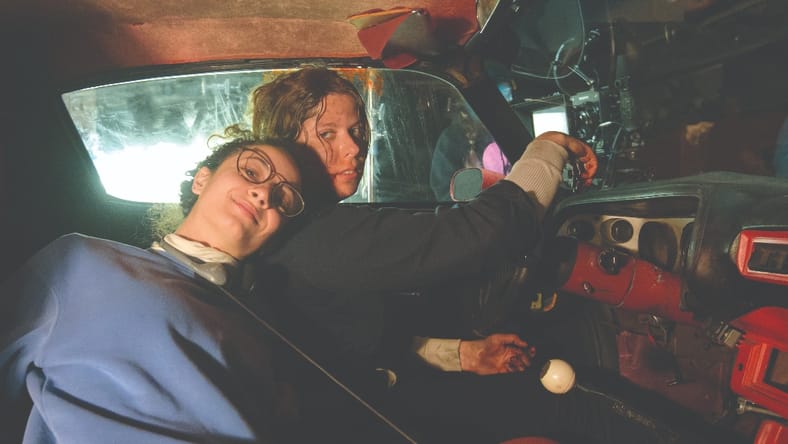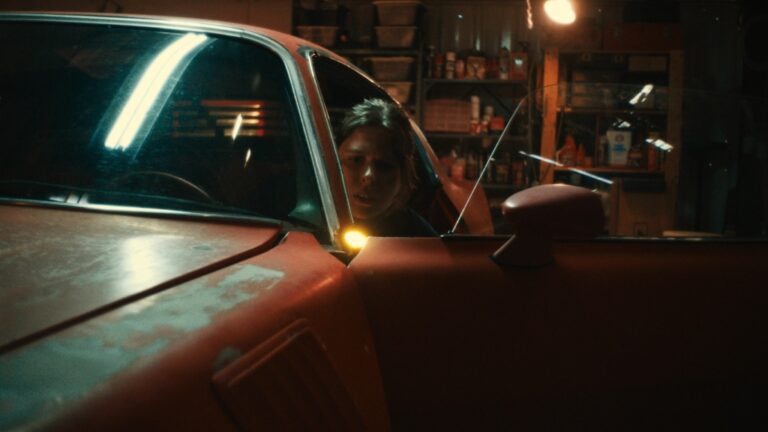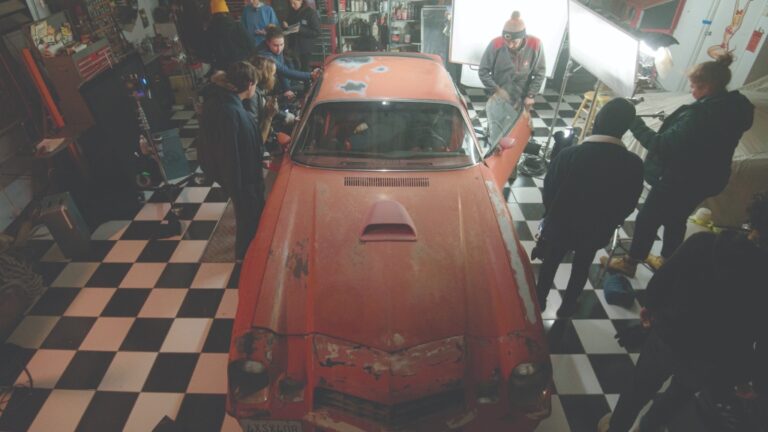
“Ride Baby Ride,” a new horror short out that has played at over 20 film festivals, is the story of a young mechanic fighting a demonic 1978 Camaro. Writer-director Sofie Somoroff knew she could pull it off when her frequent collaborator, Celina Bernstein, agreed to star — because Somoroff knew Bernstein could sell the idea that the car was trying to kill her.
“Obviously we had to do a lot of technical clever trickery to bring the car to life, but at its core it’s about the character and the believability of her fear and her fight,” Somoroff says.
You can watch the full short below, out now from Alter.
Director and Star Discuss Making the Killer Camaro Short

Here are Somoroff and Bernstein, who produced the film, in conversation about finding the perfect four-wheeled co-star.
Sofie Somoroff: In each of my films, there’s always that one thing that is the impossible task. For “Ride Baby Ride,” that was the car. The day I wrote it, I started looking into buying a decrepit ’70s car on Craigslist that we could tow around – which would have been a terrible idea.
The car had to do so much, and the challenge with working on a limited budget is that most of the time with picture cars, the cost to customize them is an insurmountable barrier. We were at a standstill until we went into FilmQuest with our previous short, “Love Is a Fire.” In a pitch for MovieMaker Production Services, with MovieMaker’s Deirdre McCarrick, everything changed. She said, “There’s a car, I know a car!”
That car of course ended up being our 1978 Camaro, which we were able to use courtesy of Picture Cars Los Angeles. It’s owned by Tony Pagliaro, who also appears in “Ride Baby Ride.”
Celina Bernstein: I would liken that whole process to casting: you’re trying to find someone – or something – that fits both the physical and emotional qualities required of the character. Hearing that Deirdre knew someone with a beat-up red Camaro who was dying to have it star in a movie — it was just so perfectly serendipitous. We had found our star.
Also Read: After John Mulaney’s Field of Dreams Oscars Moment, Fans Beg Him to Host 2025 Awards
Sofie Somoroff: Once we found the car, we scheduled our previz day, which was essentially our first rehearsal. Out of that, we devised this new scene based on what the car could actually do.
Celina Bernstein: I remember changing a lot of the smaller specifics. We asked ourselves: “Okay, we’re supposed to have the seatbelts tie me up. Does this make sense from a physical perspective? How are you supposed to be able to reach this very specific thing?” It was about figuring out the geography of the car and mapping that to what you had initially written.
Sofie Somoroff: Then we created a beat breakdown for all the action within the car. We numbered every single beat, and then shot those beats during our previz to use as our references. The most exciting part of using a set piece like this was learning how to use the full scope of the resources it offers. Like when the window crank did not work: that moment when you pull it off was true to the experience of being in there.
Celina Bernstein: I think it was so much better that we were able to find elements like that which were organic to the space.
Sofie Somoroff: It was lucky to have a car that was so beat up — it allowed its character to come through. A lot of the time, it’s harder to find the thing that’s imperfect because so many props or movie vehicles look really polished. I’ve come to find that as a filmmaker, I’m much more interested in the things that are gross, and awful, and dirty, and broken. That also comes down to how we shot the car. There’s a way to shoot a car like a car commercial, and then there’s a way to shoot a car that is like, “What is the grossest or most threatening thing possible?”
Our cinematographer Gemma Doll-Grossman and I talked about the core of the movie being your relationship with the car. The Camaro is this force of something awful and terrifying for your character. It needed to feel powerful even though it’s parked for the whole movie, so we had to lean on camera movement and dynamic angles to bring it to life. I think a lot about the tracking shot along the car where it feels so imposing – like it’s creeping into frame and blocking our view of you.
I always loved that introduction for the car because it really defines its role. And as far as literally how we shot the car, we could not have made this movie without having shot on the Sony Venice, which we rented from BeCine, an awesome women-owned rental house in Culver City. Being in Rialto mode, where the camera is so much smaller, allowed us the flexibility to put this tiny little thing on top of you, or have Gemma hold it in tight corners. That, paired with using wide lenses, allowed us to feel how dynamic the car is.
Celina Bernstein: In those initial beats of the car leering at me, the mirrors readjusting, the trunk and door opening, there are a lot of practical effects. Was it important for you to focus on practical effects?
Sofie Somoroff: It was essential that we had real things for you to interact with because I wanted this movie to be a visceral cathartic response to the awful circumstances the character goes through. Once we got into the car and you were tied up, it was a very stunt driven performance, which made it hugely emotionally satisfying.

Celina Bernstein: There are so many moments of direct physical interaction with the car that we had to do practically. One that really sticks out to me is the seat belt wrapping around my arm. Ahead of time, we had planned to try out a bunch of different methods. But in the moment, we realized that the most effective way to shoot it was to literally have somebody lasso my arm and pull it. Sometimes the simplest and most obvious way of doing something also feels the most natural and the most right. I think that throughout the film, that ended up being consistently the case.
Sofie Somoroff: We had this enormous spreadsheet where every single action that happens in the car was numbered, and there was a grid of every piece we needed from every department going into each numbered beat, as well as any safety mechanisms we needed in place.
Celina Bernstein: As an actor, my responsibility was to know at every moment what was happening and to clearly communicate it to the audience. Given the film has almost no dialogue and the other lead character is a car, if I didn’t do that, then there was no story.
Sofie Somoroff: You don’t feel it, but we shot over 60 set ups with the car. Part of that was shooting through practical effects, but it’s a ton of shots. Beth Cohon, the editor, did an amazing job figuring out this massive puzzle.
Celina Bernstein: What were some key moments that came to life in an exciting way in the edit?
Sofie Somoroff: Beth felt it was important that we come out of the car and live with the monster for a beat before it turns on, whereas I had initially intended for it to be rooted fully in your perspective. Any time we were able to pull out for a beat made the moments when we dove back into the horror much more effective.
Celina Bernstein: What advice do you have for anyone making a movie where they’re bringing an inanimate object to life?
Sofie Somoroff: Focus on the relationship and look at the object through the character’s perspective. Filmmaking is the art of point of view, and there are a lot of tools that we can use to define that point of view in a dynamic way. What about you?
Celina Bernstein: Trust the people around you and work towards building the kind of community necessary to pull something like this off. When we didn’t have the budget to hire a special effects person, we trusted our incredible friends and collaborators.
This story originally appeared in print in MovieMaker Magazine.
Watch “Ride Baby Ride” Below
Main Image: Writer-director-producer Sofie Somoroff and actor-producer Celina Bernstein hang in the 1978 Camaro. Photo Credit: Scott Lewis
Share:

